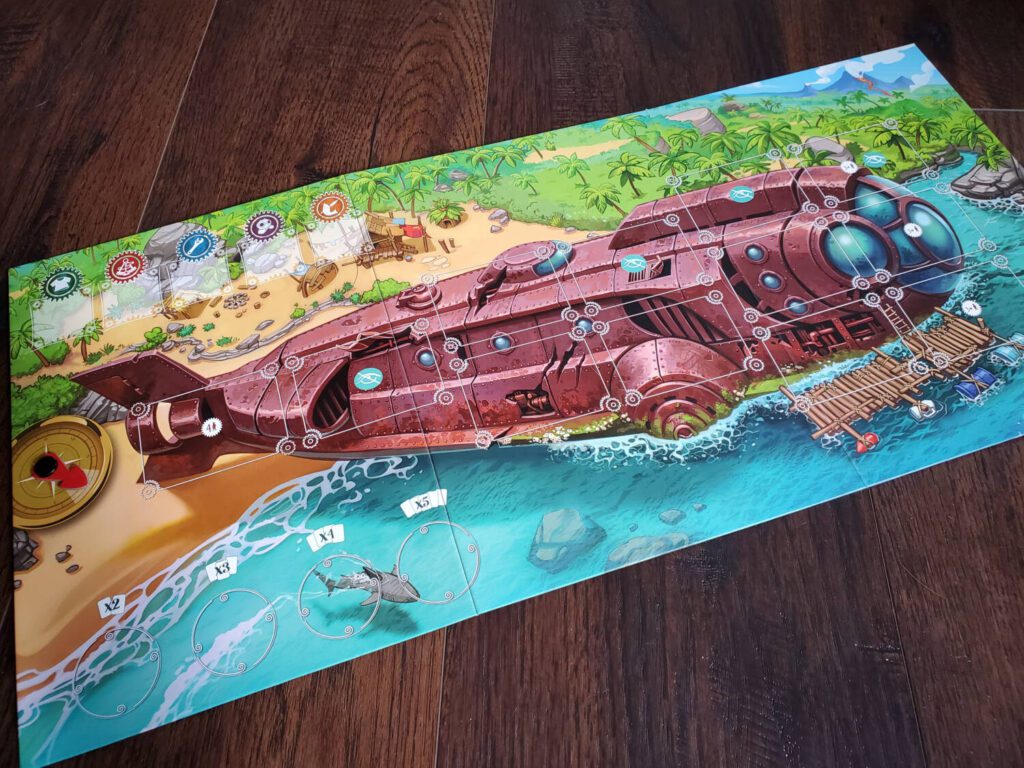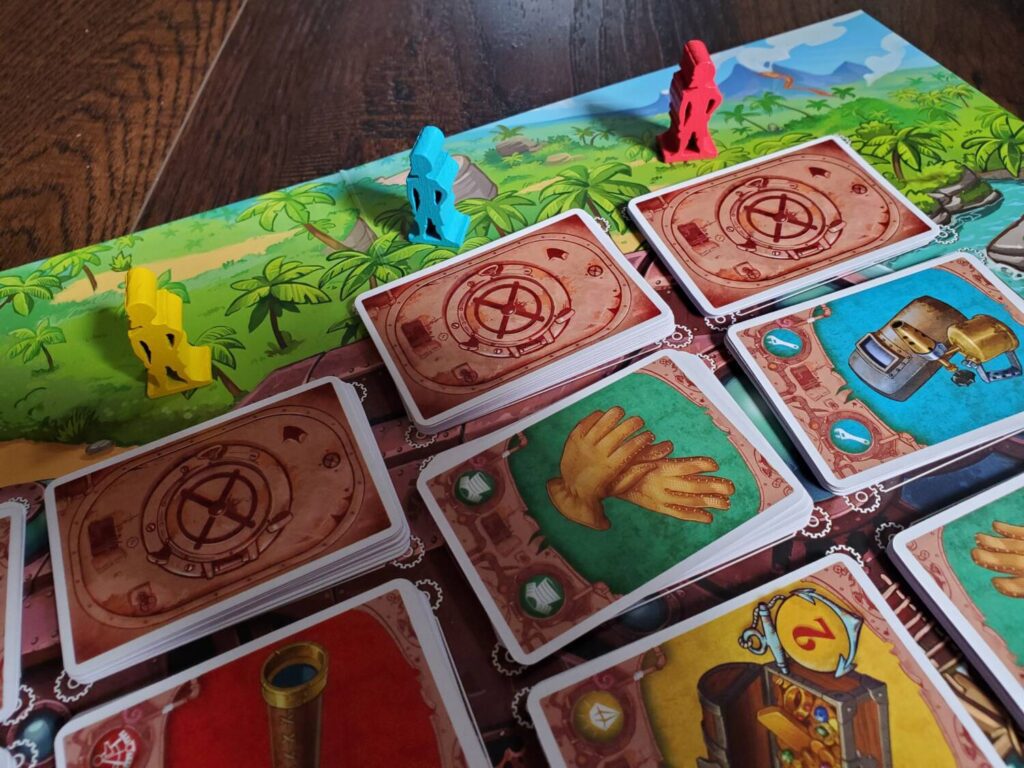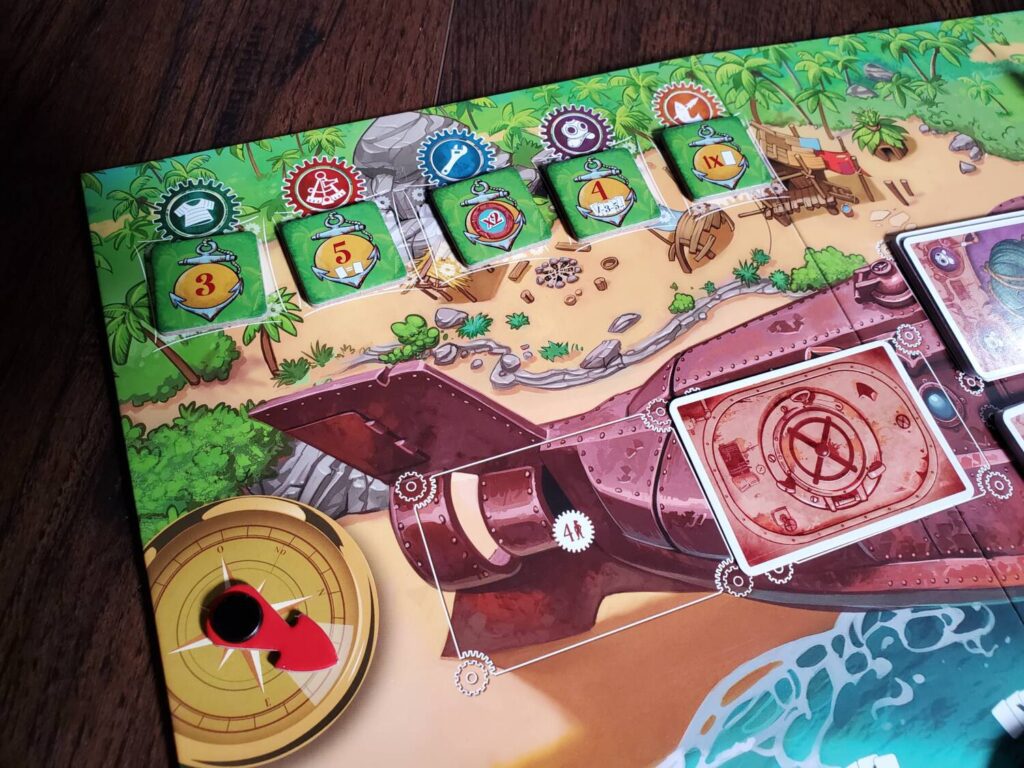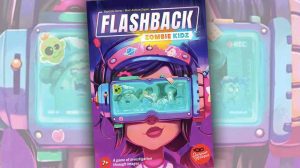Disclosure: Meeple Mountain received a free copy of this product in exchange for an honest, unbiased review. This review is not intended to be an endorsement.
My last experience with a title from Johannes Goupy (co-designed with Bruno Cathala) was Orichalcum, the 2022 race off a cliff from Pandasaurus Games. But Théo Rivière, via his relationship with the Kaedama design group, has a less chaotic reputation in our house with a game like Draftosaurus. Together, the two released Rauha earlier this year. Their latest, Nautilus Island, puts players aboard a beached submarine to scavenge the goods—and neatly organize them—better than the other castaways on the island so as to win the right to take off in Captain Nemo’s leftovers.
Substance
The central board in Nautilus Island depicts a submarine (before you cover it with cards and nearly forget it’s a submarine). From left to right, there are columns of 1–1–2–2–3–3 stacks of cards, with notation as to whether they lay face-up or face-down. Player count determines the number of stacks in play. Players will loot these stacks of eight, creating collections in front of them until one stack dwindles to nothing, revealing the sub once again and triggering the endgame.

On each turn, players move their castaway meeple to the edge (let’s say the top) of one of the columns, deciding either to collect the top card of each stack in the column or store up to that many color-matched cards face-up in front of them. Only one player can visit each column in each round. If the choice is to store, the player also checks to see if there is an available bonus token for that color on the board. If so, they collect the token and place it atop their collected set. The token(s) will determine the scoring condition(s) for the set.

Once the players are all atop a column, a new round begins by moving the board’s compass arrow toward the opposite edge (let’s now say the bottom). Beginning with the meeple furthest back on the sub, players do it again, choosing a new column and a new action along that opposite edge of the sub.
The bonus tokens are replenished when only one remains. The full complement includes one for each card color (except treasures, so five), which means there are turns in which no bonus token is available for storing cards. Treasure cards remain hidden in a player’s hand until the end, while the other five colors of cards are, ideally, played into the sets.

Four stacks of porthole tokens add intrigue to the process. Upon storing cards, players may choose to take the topmost porthole token from the stack with the corresponding number of cards (two through five). Doing so grants a one-time bonus, but adding the porthole to the set seals it off for the remainder of the game. Of course, the tokens diminish in value as the stacks shrink, creating a particular temptation to get there first.
When the game ends, players score their stacks according to the conditions on the bonus tokens. One might grant a point per card in the set, while another gives four points if the set has an odd number of cards (1, 3, or 5). One doubles the value of the porthole, and another gives five if the set contains two matching items within the set. Others yet give flat points just for having them. It is possible to have multiple conditions on one set, so there are possibilities. Treasure cards have a printed value to add as well when they are revealed.
Subjectivity
Nautilus Island is definitely simple enough for a small child to play along, despite the grim fact that it is a game of out-scrounging your friends on a deserted island (and that the winner is repairing the ship so as to leave…alone?). Our six-year-old has joined us for games. She doesn’t really feel the tension of it all, but the art is colorful and she likes collecting things. But there are also some deeper struggles in the game that make this one interesting for the whole family.
Choosing a column is relatively easy. On your turn, there will only be so many available. The primary tension comes from choosing whether to block a particular row (so that Caleb can’t gobble up those set pieces he so obviously needs), gobble in preparation for a future turn (assuming you can get back to a 3-spot to lay them all down), or move to the back of the sub to claim the first-player spot for the next round.

The umbrella over this decision is the plainly visible game timer in the form of dwindling stacks. Late in the game, you might choose a column to keep someone else from ending it all before you have a chance to tidy up your final set.
The portholes keep the game lively. Getting that top token for a set of five is tempting, but it involves collecting five of one color (which will take at least two turns and probably three or more), then revisiting the properly sized columns to lay down the five cards just to snag the porthole. Oh, and hopefully collecting the best bonus tokens along the way so that the whole endeavor is worth the singular focus.
If anything in the game feels odd, it’s the fact that the cards are so nicely illustrated but only one of the potential scoring conditions has anything to do with those illustrations. This one is all about the colors and the values. That being said, it’s a cute way to introduce a largely abstract thought process.
I would hardly call Nautilus Island an enduring classic. The mechanisms are a bit on the clunky side, perhaps more difficult to explain than they ought to be. But there is fun in this one. I think families could enjoy the submarine for a while. I think a table of gamers might get a little less out of it, but not without saying, “that’s a clever little game,” or something similar Not every decision draws sweat, but in a family affair I’m not sure they all need to. Sometimes you’re just looking for a gentle half-hour, and that is exactly what Nautilus Island provides.











Add Comment